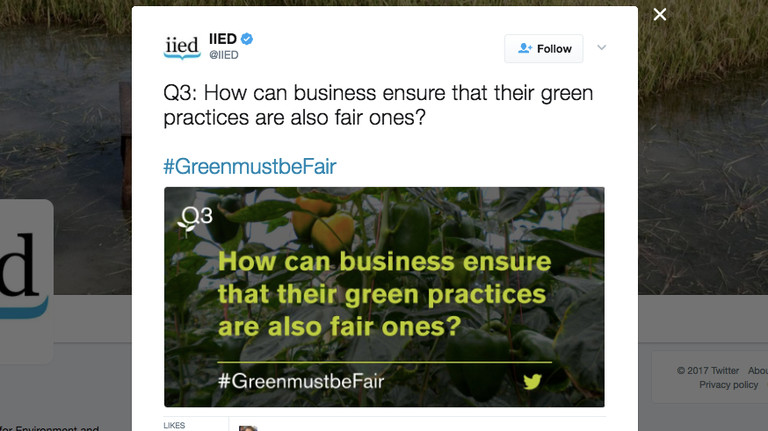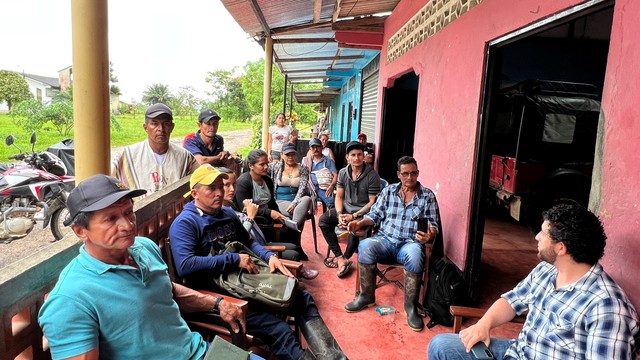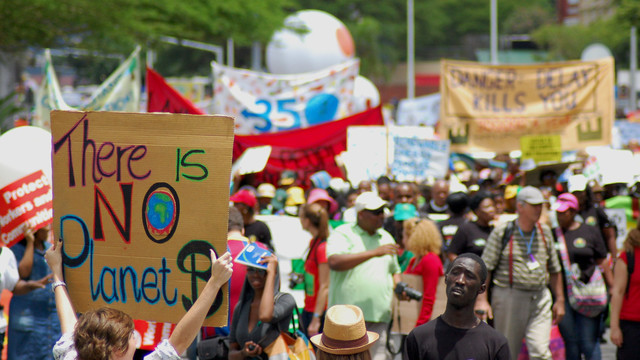Creating a conversation online
IIED recently hosted our first Twitter chat. Matt Wright reflects on getting the most out of targeted online discussions.


IIED and partners organised a Twitter chat on how to manage the transition to a green and fair economy (Image: Nick Turner/IIED)
The social media platform Twitter has become the go-to place for anyone wanting to know what the new US president is thinking, but Twitter offers so much more than the opportunity to broadcast outspoken views.
We wanted to explore the platform's potential to engage with a wide and varied audience around the world in a way that is inclusive, cost-effective and immediate. The results of our first Twitter chat were encouraging.
We decided to use the Twitter chat format, a public conversation around a unique hashtag, to engage with our target audience for a specific area of work.
We wanted to create an online conversation linked to the discussions taking place at the UN PAGE Ministerial Conference in Berlin. Our aim was to highlight some issues related to green economies and to promote an online conversation around them.
This was not simply about promoting our own research and thinking. We wanted to hear and share others' views, to foster genuine discussion with a varied group of participants. The Twitter chat format is particularly suitable for us because collaboration and communication are central to IIED's way of working.
We created the hashtag #GreenmustbeFair to link the conversation, and invited our partners, the NGOs Green Economy Coalition (GEC), Development Alternatives (DA), Plan International UK and CAFOD to co-host the Twitter chat – bringing organisations into the conversation that we knew had relevant expertise.
We then worked with GEC to come up with six questions to drive the conversation – and promoted these ahead of the scheduled chat.
All in all, 54 people engaged in the Twitter chat, with more than 200 posts made sharing views, knowledge and valuable resources during the allocated hour. This initial conversation was followed up by another 50 or so over the next couple of days. Others contributed without using the hashtag. Our Storify captures a flavour of the discussions that took place.
What did we learn?
Twitter is a fast-paced – and often fun – environment, but laying the groundwork for a successful Twitter chat takes time. It's perhaps a common comms gripe, but because the chat was organised at short notice, we were only able to do a limited amount of promotion.
Nobody ever gets as much time as they'd like, but it would have been good to have been able to try to take the conversation to a wider audience, and with a few more days' lead-in, we could have researched other key people who might have been interested in taking part.

Having visually-appealing material really helped. We designed Twitter cards around the issues and questions, and used these to brand the conversation, helping it to stand out. We also used posters that IIED had produced for the conference, which provided concise summaries of some of the issues being talked about.
Named individuals help the conversation. While all of the partners contributed to the discussion, only CAFOD made it clear that their tweets were coming from head of policy, Graham Gordon – giving a more personal dimension. In future we would aim to involve further individual researchers and experts and encourage them to participate as individuals, in order to give the discussions more depth.
Looking forward to today's discussion on why #GreenmustbeFair. Graham Gordon, CAFOD's head of policy, tweeting from @CafodWire
— CAFOD Policy (@CAFODwire) March 28, 2017
We tried to make it easy for staff and partners not familiar with the Twitter chat format by producing a best practice guide (PDF). A longer lead-in time would have enabled us to publicise our guide more widely.
Finally, six questions was perhaps a few too many. A new question every 10 minutes sounds practical, but didn't leave much time for conversation before a new topic was broached. When we do our next Twitter chat we'll likely focus on fewer, more provocative, questions.
A broader space for dialogue
Our Twitter chat experiment followed our second #shareASM digital day in February. This event was focused on sharing views and resources among the varied and global artisanal and small-scale mining (ASM) community.
IIED's dialogue programme for artisanal and small-scale mining centres on enabling a wide range of stakeholders to come together and collaborate on empowering miners, improving governance and delivering a safer, more secure working environment. This digital day was therefore different in that it was designed to profile our work on ASM and to encourage those interested to talk to one another – rather than inviting responses to a series of questions. It took place over a 24-hour period, allowing conversations to stretch across time zones.
We again used a hashtag (#shareASM) to bring the conversation together, and we stimulated interaction among a good and varied number of participants. There were 167 posts made by 51 users using the hashtag over a three-day period.
This attracted new audiences for IIED's ASM work, and we were able to add new contacts to our 'Focus on ASM' Twitter list, and an increased number of views for the content we profiled.
But just as valuable were the discussions triggered between key players in the ASM sector, including conversations around upcoming events. Again, we captured some of the flavour of these in a Storify.
With #shareASM, advance planning meant we were able to promote the day more widely, with a news story, postings to a key mining network, and further activity on our other social media channels. We were also able to engage with members of the Focus on ASM list through direct messages to flag the day, and prepare relevant content.
Adding value
Both activities show the value of using social media to conduct strategic outreach, bringing IIED into contact with new audiences, and generating useful exchanges of views and information.
To make the most of this, it is important to plan ahead and identify your potential audience. Targeted outreach is essential to get the right people involved on the day.

Both these approaches offer an important advantage: they provide a platform for smaller organisations and community partners, allowing previously unheard voices to join the conversation and be heard, and a chance for a proper conversation rather than the simple 'broadcast' activity that is all too common on social media. They also provide valuable opportunities to monitor and evaluate your impact, allowing you to learn from what you have done.
Matt Wright (matthew.wright@iied.org) is IIED's website planning and content manager.



